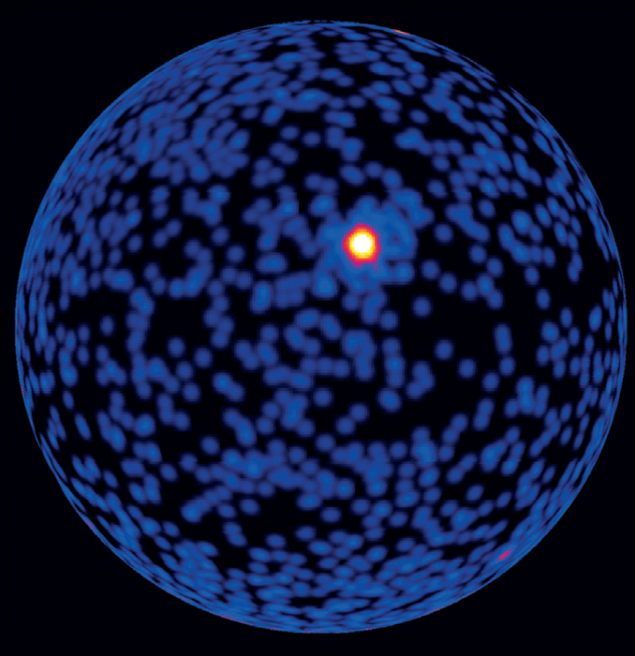
Image credit: NASA/DOE/Fermi LAT Collaboration.
The very bright, relatively nearby gamma-ray burst (GRB) of 27 April 2013 – GRB 130427A – offers astronomers the most complete set of observational data of this phenomenon to date. While its general properties are in line with theory, the detection of extremely energetic gamma rays and other intriguing features challenges synchrotron-shock models.
GRBs are extremely powerful flashes of gamma rays arising about once per day from an arbitrary direction in the sky. Astronomers have known for about a decade that long GRBs are associated with the supernova explosion of massive stars (CERN Courier September 2003 p15). Since then, the dedicated Swift satellite has detected hundreds of gamma-ray bursts, therefore providing a huge data set of GRB observations (CERN Courier December 2005 p20). On 19 March 2008, Swift detected an extraordinarily bright burst, GRB 080319B, bright enough to see with the naked eye (CERN Courier June 2008 p12). However, it was the Gamma-ray Burst Monitor on board the Fermi Gamma-ray Space Telescope that gave the alert last year of the new record-setting GRB 130427A. The long duration and extreme brightness of this burst allowed the collection of an impressive data set from 58 ground- and space-based observatories, described and interpreted in four recent articles in Science.
Although slightly dimmer in the visible range than the one of 2008, the burst of 2013 was the brightest detected so far in the X-ray and gamma-ray range by the Swift and Fermi satellites. Maselli and collaborators point out that while the overall properties of GRB 130427A are similar to those of the most luminous, high-redshift GRBs, this time the burst was relatively nearby (redshift z = 0.34) – although still a quarter of the distance across the observable universe. The observed similarity suggests that there is no fundamental difference between recent, nearby GRBs and those of the early, remote universe. The detection of a supernova associated with this very bright GRB is further evidence that this relationship also holds for the most luminous GRBs, and strengthens the case for a common engine that powers all kinds of long GRBs.
This extraordinary burst is therefore an ideal laboratory for testing current models of GRBs. In the standard picture, the supernova explosion is accompanied by the formation of a black hole from the collapse of the massive star’s core. The accretion of matter onto this rapidly spinning black hole then launches a jet that finds its way through the star’s outer layers and into the surrounding gas. Shock waves propagating inside the jet and at its outer boundary would be at the origin of the prompt and afterglow emission, respectively.
One surprise is that the Large Area Telescope (LAT) on the Fermi satellite detected energetic gamma rays for 20 hours after the onset of the burst. Among them, two events of 73 GeV and 95 GeV are the highest-energy photons from a GRB ever recorded. The analysis of these data by the Fermi collaboration challenges the widely accepted model that this high-energy emission is of synchrotron origin. A natural additional emission component would be synchrotron self-Compton emission as Maselli and co-workers describe. In this process, the relativistic electron population in the jet both produces the synchrotron emission and then up-scatters these synchrotron photons to high energies via inverse-Compton interactions. While the overall understanding of GRBs seems to be valid, Preece and colleagues conclude, however, that it is difficult for any of the existing models to account for the observed spectral and temporal behaviours displayed by this rare GRB event.








